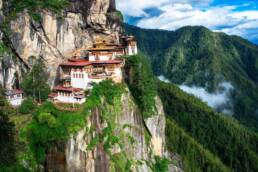A rebuilt trail in the Himalayas ensures walkers worldwide find their happy place. By Dave Quinn
The Himalayan mountain kingdom of Bhutan, landlocked between India and China, is known for its visionary policy of a Gross National Happiness Index. Cultural well-being sculpts the country’s development policy instead of gross national product. It’s also one of the last remaining carbon-negative countries on the planet. Human-powered tourism is integral to the economy and ethos of the country, and the recently reconnected 403-kilometre-long (250-mile-long) Trans Bhutan Trail (TBT) plays an important role. The TBT is a path back in time that winds over passes and through mountain valleys and remote villages that roads have not yet reached, and it’s on nearly every walker’s list of great hikes to do before they die.
With the construction of a national highway system in the 1950s, commerce and infrastructure migrated to these modern roads, nearly killing the network of mountain trails and bridges that connects the villages and valleys of Bhutan. This changed in 2018 when a partnership between the Bhutan Canada Foundation and the Tourism Council of Bhutan revitalized the TBT, reconnecting remote villages across Bhutan to foot, bike, and horse traffic. COVID-19 stimulus projects employed 900 displaced workers to rebuild 18 bridges and more than 10,000 stone steps across hundreds of kilometres of trail.
Bhutan has stuck to its policy of low-volume, high-value tourism by mandating that TBT hikers use licensed guides only and pay a US$250 daily permit fee. The sticker shock is dulled when you consider this includes all transportation, accommodation, and food—and helps ensure Bhutan will remain one of the happiest places on Earth.
Dave Quinn
Born in Cranbrook, British Columbia, Dave is a wildlife biologist, educator, wilderness guide, writer and photographer whose work is driven by his passion for wilderness and wild spaces. His work with endangered mountain caribou and badgers, threatened fisher and grizzly, as well as lynx and other species has helped shape his understanding of the Kootenay backcountry and its wildlife, and help shape his efforts to protect what remains. His writing and photography has helped fill the pages of publications such as British Columbia Magazine, Westworld, the Financial Post, Backcountry, Adventure Kayak, as well as the Patagonia and MEC catalogs.
Related Stories
Pillow Line by Kari Medig
Nelson-based photographer Kari Medig recently won the Kootenay Coldsmoke Powder Festival's Coldshot Photo Competition…
CMC Feature Series – Life On The Line
To the west, a market of 1.5 billion consumers. To the east, the planet’s dirtiest oil. And in the middle, a colossal…
Shambhala Announces its 2022 Line-up
Shambhala, Canada’s longest-running electronic music festival, released its 2022 lineup today after a two-year hiatus.…
True Trans Soul Rebel – The Against Me Album Review
Against Me!, Transgender Dysphoria Blues (Total Treble Music), 2014 On the title track of the sixth studio offering…
Dream Line — Ptor Spricenieks Documentary by Endless Flow
PRESS RELEASE: Bjarne Salen and Endlessflow Films proudly presents a new documentary film 'Dream Line'. The 1 hour…
Canadian Freeskier Kye Petersen Launches New Line of Skis
Pemberton, British Columbia freeskier Kye Petersen has launched a new line of skis with the help of local legend Johnny…








